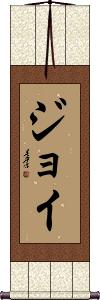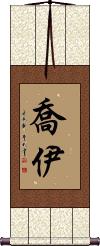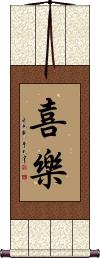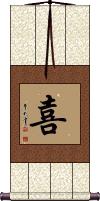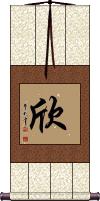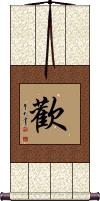Many custom options...
And formats...

Joy in Chinese / Japanese...
Buy a Joy calligraphy wall scroll here!
Personalize your custom “Joy” project by clicking the button next to your favorite “Joy” title below...
Happiness / Joyful / Joy
喜 is the Chinese, Japanese Kanji, and Korean Hanja for the kind of happiness known in the west as “joy.”
喜 can also be translated as rejoice, enjoyment, delighted, pleased, or “take pleasure in.” Sometimes it can mean “to be fond of” (in a certain context).
If you write two of these happiness/joy characters side by side, you create another character known in English as “double happiness,” which is a symbol associated with weddings and happy marriages.
There is another version of this character that you will find on our website with an additional radical on the left side (exactly same meaning, just an alternate form). The version of happiness shown here is the commonly written form in China, Japan and South Korea (banned in North Korea).
See Also: Contentment | Happiness
Happy
欣 is the type of happiness that you feel on the inside. It is the feeling of being released and delighted as well as being in a state of contentment. 欣 is more the internal happiness that perhaps only shows by the smile on your face. It can also be translated as “to take pleasure in” or “to rejoice.”
Note: 欣 is often used in compound words - especially in Korean Hanja.
As Japanese Kanji, this is so rare, that most Japanese people are not aware of its existence.
See Also: Happiness
Joyful
歡 means joyous, happy, delightful, and pleased.
歡 represents external happiness that may have you clapping and cheering.
Please note: The other happiness/joyful which looks like "喜" is more popular.
歡 is the ancient/old version in China and Japan. After WWII in Japan, they started using 歓. Just let us know if you want this modern version instead of the ancient one.
See Also: Happiness
These search terms might be related to Joy:
A Life of Happiness and Prosperity
Charisma / Charm
Charm / Grace
Dharma Gate of Bliss
Doing Good is the Greatest Source of Happiness
Double Happiness
Double Happiness Guest Book
Eternal Happiness
Family Love / Domestic Bliss
Feeling of Bliss
Happiness
Happiness / Contentment
Happiness / Fortune / Lucky
Happiness / Joy
Happiness / Joyful / Joy
Happiness in the Afterlife
Happy / Laughter / Cheerful Bliss
Inner Bliss and Peace From Meditation
Joyfulness / Happiness
Love and Happiness
Peace, Love, Happiness
Pleasure
Prosperity and Happiness
Pursuit of Happiness
School of Happiness
Seven Rules of Happiness
Sweet / Sweetness / Charm
There is No Pleasure Without Pain
The following table may be helpful for those studying Chinese or Japanese...
| Title | Characters | Romaji (Romanized Japanese) | Various forms of Romanized Chinese | |
| Joy | ジョイ | joi | ||
| Joy | 喬伊 乔伊 | qiáo yī / qiao2 yi1 / qiao yi / qiaoyi | ch`iao i / chiaoi / chiao i | |
| Joy | 喜樂 喜乐 | kiraku | xǐ lè / xi3 le4 / xi le / xile | hsi le / hsile |
| Happiness Joyful Joy | 喜 | ki / yorokobi | xǐ / xi3 / xi | hsi |
| Happy | 欣 | kin | xīn / xin1 / xin | hsin |
| Joyful | 歡 欢 / 歓 | kan | huān / huan1 / huan | |
| In some entries above you will see that characters have different versions above and below a line. In these cases, the characters above the line are Traditional Chinese, while the ones below are Simplified Chinese. | ||||
Successful Chinese Character and Japanese Kanji calligraphy searches within the last few hours...
